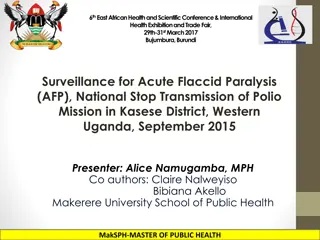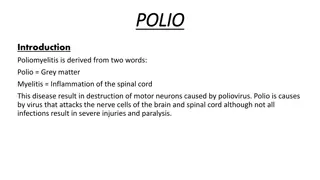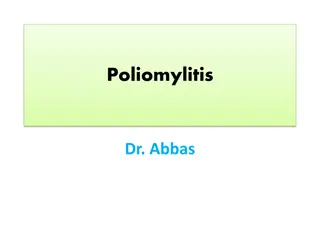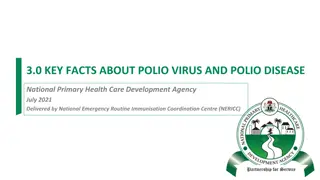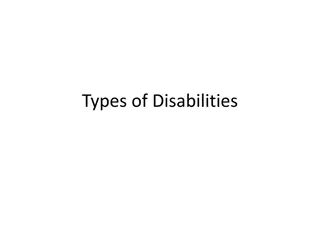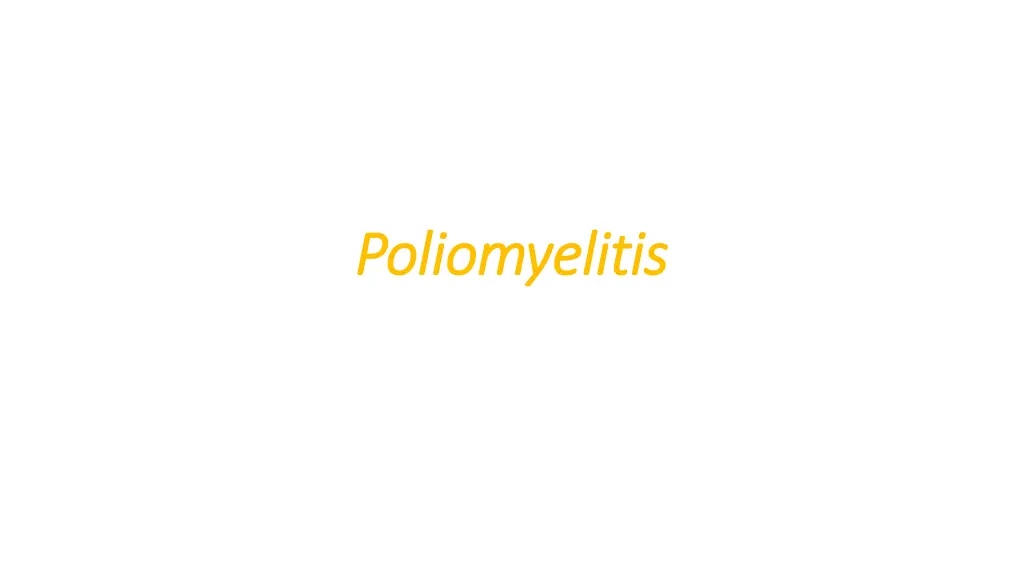
Understanding Poliomyelitis: Causes, Types, and Transmission
Poliomyelitis, commonly known as polio, is a viral disease that mainly affects young children. Learn about its history, causes, types, mode of transmission, and pathophysiology. Discover why polio remains a concern in many parts of the world and how it can lead to devastating paralysis.
Download Presentation

Please find below an Image/Link to download the presentation.
The content on the website is provided AS IS for your information and personal use only. It may not be sold, licensed, or shared on other websites without obtaining consent from the author. If you encounter any issues during the download, it is possible that the publisher has removed the file from their server.
You are allowed to download the files provided on this website for personal or commercial use, subject to the condition that they are used lawfully. All files are the property of their respective owners.
The content on the website is provided AS IS for your information and personal use only. It may not be sold, licensed, or shared on other websites without obtaining consent from the author.
E N D
Presentation Transcript
Poliomyelitis Poliomyelitis
Introduction Introduction A terryfying communicable disease resulting in devastating paralysis, polio continues to be prevalent in much of the developing world. Poliomylitis is first known to have occurred nearly 6,000 years ago, as evidenced by the withered and deformed limbs of certain Egyptian mummies. Polio was epidic in the United States and the world in the 20th century, especially in the 1040s to 1950s. Poliomylitis is a highly infectious viral disease, which mostly affects young children, the virus is transmitted by person to person spread mainly through the fecal oral route.
Definition Definition Is an acute infectious disease caused by any of the types of poliomyelitis virus which affects chiefly the anterior horn cells of the spinal cord and the medulla, cerebellum and midbrain. Characterised by two febrile episodes, a minor and major illness separated by a remission of one or two days followed by varying degrees of muscle weakness or occasionally a progressive paralysis.
Causes Causes The causative virus is poliovirus There are three distinct serological type of poliovirus Type I is most paralytogenic or the most frequent cause of paralytic poliomylitis both epidemic and endemic. Type II the next most frequent Type III the least frequently associated with paralytic disease.
Types of poliomyelitis Types of poliomyelitis Spinal Cervical Thoracic Lumber Bulber Cranial nerves Circular system Respiratory system Bulbospinal Polioencephalitis
Mode of transmission Mode of transmission Fecal oral route Oral route through pharyngeal secretions Contact with infected persons Incubation period Usually 7-14 days with a range of 5-35 days for Paralytic and nonparalytic forms 3-5 days for the minor illness
Pathophysiology Pathophysiology Poliovirus is an RNA virus that is transmitted through the oral fecal route or by ingestion of contaminated water. Three serotype are able to cause human infection The virus particles initially replicate in the Naso pharynx and GI tract then invade lymphoid tissue, with subsequent hematologic spread. After a period of viremia, the virus become neurotropic and produces destruction of the motor neurons in the anterior horn and brainstem. The destruction of motor neurons leads to the development of flaccid paralysis, which may be Bulber or spinal distraction.
Clinical manifestation Clinical manifestation Most patients infected with poliovirus develops inapparent infections and are frequently asymptomatic. Nonspecific symptoms Fever, headache, Nausia and vomiting Abdominal pain Oropharyngeal hyperaemia are observed in mild cases and usually resolve within few days.
Non paralytic poliomylitis It is characterized by the symptoms described above the addition to the following Nuchal rigidity More severe headache Back and lower extremity pain Meningitis
Diagnostic findings Diagnostic findings To confirm the diagnosis, a sample of throat secretions, stool or a colorless fluid that surrounds your brain and spinal cord CSF is checked for poliovirus. Viral culture Obtain specimen from the CSF, stool, and throat for viral culture in patients with suspected poliomylitis infection Serum antibody Obtain acute and convalescent serum for antibody concentration against three polio virus
Medical management Medical management The treatment of poliomyelitis is mainly supportive Physical therapy Is indicated in cases of paralytic disease in paralytic disease it provides frequent Mobilization to avoid the development of chronic diabetic ulceration active and passive exercises are indicated during the convalescent stage. Total hip arthroplasty it is a Therapeutic option for patients with paralytic sequel of poliomyelitis who develop hip dysplasia and degenerative disease
Diet Becouse patients with poliomyelitis are prone to develop constipation, a diet rich in fiber is usually indicated Pharmacological management No antiviral agents are effective against poliovirus
Nursing diagnosis Nursing diagnosis Imbalanced nutrition less than body requirement related to anorexia nausea and vomiting. Ineffective thermoregulation related to the infection process. Ineffective Airway clearance related to muscle paralysis. Ineffective breathing pattern related to muscle paralysis. acute pain related to the infection that attack the nerve . Impaired physical mobility related to Paralysis. Anxiety in children and families related to disease condition.

